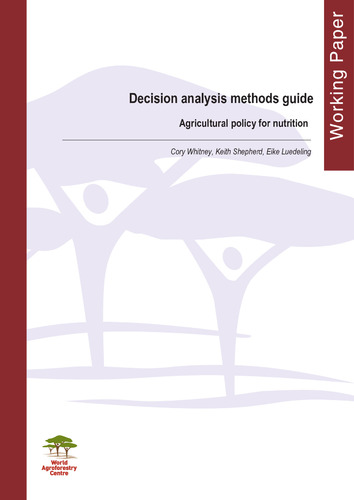Decision analysis methods guide: agricultural policy for nutrition
Abstract
It is often very difficult to make accurate projections about how interventions will affect the real
world and to use such projections to develop effective implementation plans, monitor progress and
evaluate project impacts. This is due to a variety of factors including lack of data, complex impact
pathways and risks and uncertainties that are difficult to factor into intervention planning. Scientific
approaches to produce reliable impact projections are rarely applied in agricultural development, but
Decision Analysis techniques commonly used in other fields have the potential to improve
development decisions. This working paper outlines a Decision Analysis approach that can help
decision makers efficiently allocate resources to enhance the effectiveness of policy decisions.
The procedures outlined in this publication feature the construction of causal models – models that
describe the mechanisms through which intervention impacts will be delivered – that are codeveloped
by experts, stakeholders and analysts through facilitated participatory processes. These
models are then formalized as Bayesian Network (BN) models, a modelling approach that has been
widely applied in a range of disciplines, including medical sciences, genetics, environmental sciences
and legal reasoning. BNs allow for the formal representation of causal models, such as intervention
impact pathways. They can work effectively with incomplete information, combine expert knowledge
with other sources of information and allow for adequate consideration of risk.
This paper illustrates the use of participatory workshops that convene experts on the systems,
stakeholders involved in ongoing or prospective projects and analysts. These teams can jointly
develop impact pathways for the interventions, which can be formalized into quantitative BN models.
After several rounds of feedback elicitation and the inclusion of data from experts and other sources,
stochastic simulations can be run to determine the likely impacts of the interventions. Results can be
presented back to stakeholders for feedback.
Through the tools presented in this working paper, critical uncertainties in the models of intervention
impact pathways can be identified. These high-value variables can determine uncertainty about
project outcomes. Further measurement or disaggregation of these variables can support decisionmaking
processes.
By demonstrating improved intervention decisions with little additional investment and improved
tools for intervention decision modelling, we hope that this approach will be widely adopted and used
to enhance the efficacy of development activities

